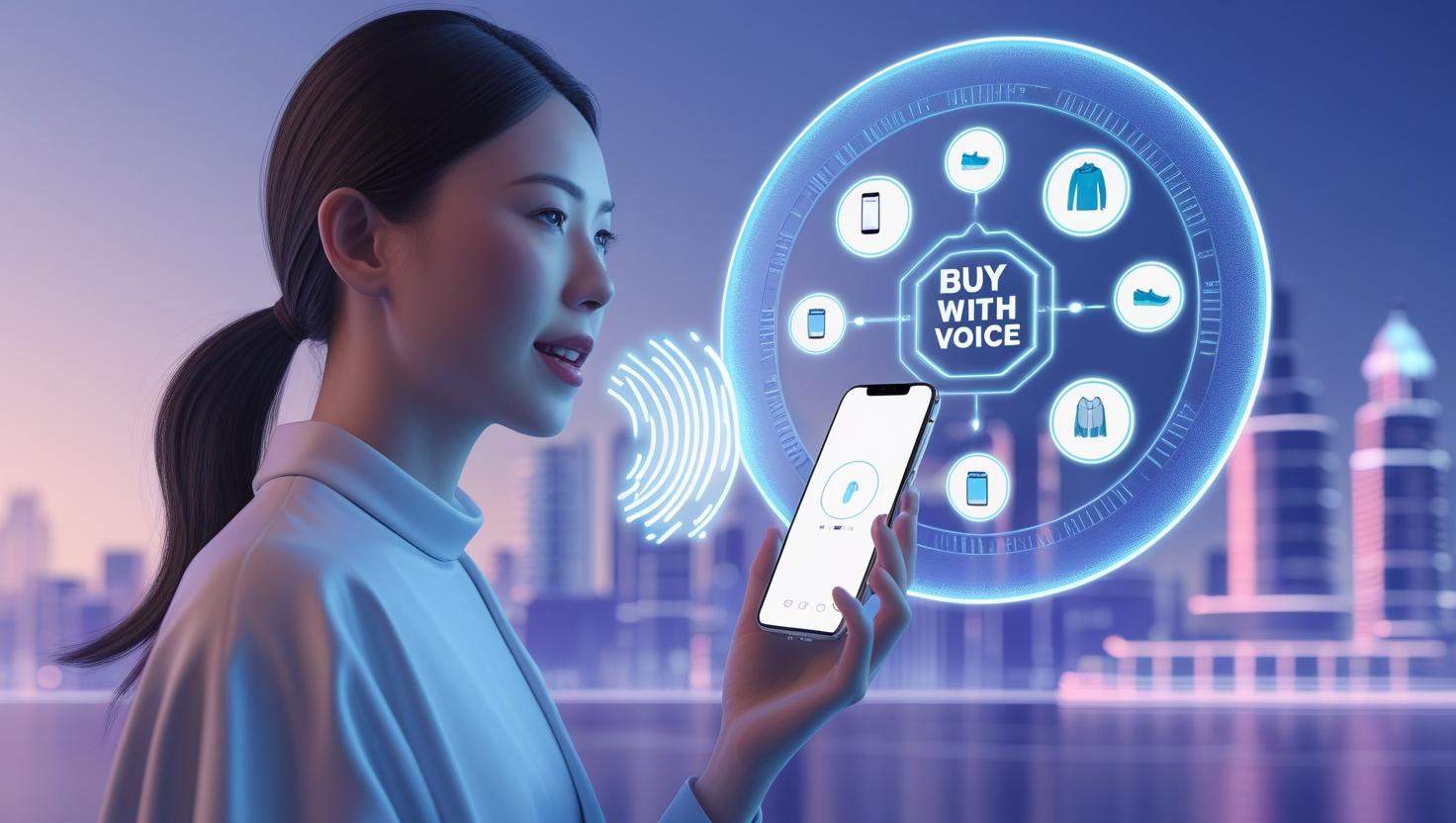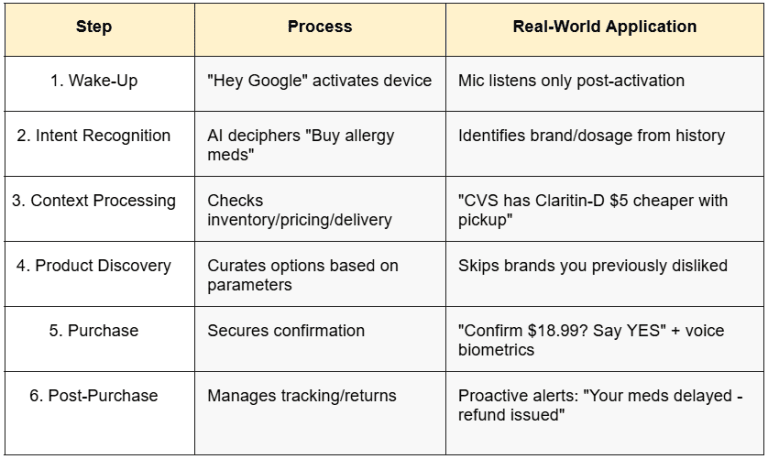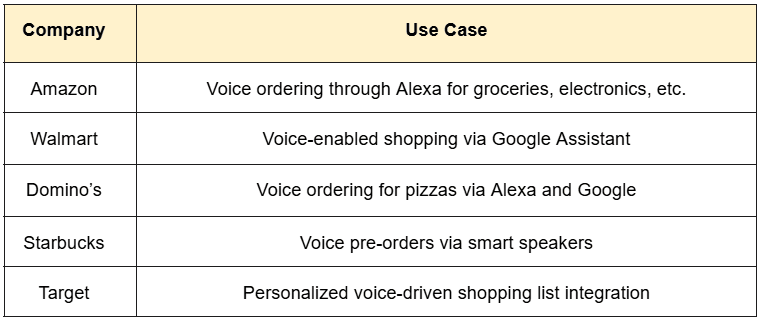
What is Voice-First Commerce?
Voice-first commerce refers to the buying and selling of goods and services through voice-enabled devices and interfaces, where speech is the primary mode of interaction. It enables consumers to interact with digital shopping platforms through natural language conversations, rather than relying on visual interfaces like websites or mobile apps.
Voice-first commerce blends the power of:
- Conversational AI
- Speech recognition
- Natural Language Processing (NLP)
- Context-aware decision-making
- Smart speaker ecosystems
How Voice-First Commerce Works Step-by-Step Journey

Core Technologies of Voice Commerce
1. Voice Assistants
- Amazon Alexa
- Google Assistant
- Apple Siri
- Samsung Bixby
2. Speech-to-Text Engines
- Convert spoken language into machine-readable text.
3. Natural Language Understanding (NLU)
- Understands user intent, semantics, and context.
- Detects urgency in “Find bandaids NOW!”
4. Conversational AI
- Manages dialogue, remembers context, and responds fluidly.
- User: “Add milk” → AI: “Organic or almond? Last: Horizon”
5. Voice Biometrics
- Recognizes users based on their voiceprint for security and personalization.
- Security layer: Blocks unauthorized purchases via voiceprint ID
5 Key Features of Voice Commerce
1. Hands-Free Interaction
- Perfect for multitasking or accessibility, users can shop while cooking, driving, or working out.
- Example:
“Alexa, order more paper towels.”
No screen. No tapping. Just voice.
2. Conversational Shopping
Instead of browsing through filters, users can have a natural back-and-forth with their assistant:
User: “Find me a lightweight running shoe under $100.”
Assistant: “I found Adidas Cloudfoam at $89. Do you want to hear more details?”
3. Personalization
- Based on purchase history, preferences, and tone, the assistant offers tailored recommendations.
- Example:
“You usually order green tea every two weeks. Shall I reorder it now?”
4. Speed and Convenience
- Faster than navigating apps or websites. Shopping can take seconds.
- Example:
“Buy dog food – same brand and size as last time.”
5. Security and Voice Authentication
Voice biometrics and 2FA (two-factor authentication) are used to prevent unauthorized purchases.
Real-World Applications of Voice Commerce
1. Reordering Essentials
Users reorder household items through smart speakers.
Example:
“Google, reorder my last Amazon order of dish soap.”
2. Ordering Food or Groceries
Integrated with services like Domino’s, Uber Eats, and Walmart.
Example:
“Alexa, order a large pepperoni pizza from Domino’s.”
3. Booking Services
Flights, hotels, ride-shares can be booked using natural language.
Example:
“Siri, book me an Uber to the airport.”
4. Gift Recommendations
AI suggests gifts based on voice queries like:
“Alexa, find a birthday gift for my dad under $50.”
5. Tracking and Returns
After purchase, voice assistants handle logistics too.
Example:
“Hey Google, where’s my last order?”
Voice Commerce Market Reality Check
➤ $80B+ voice commerce market by 2028
➤ 55%+ U.S. households own smart speakers
➤ >50% smartphone users use voice search daily
➤ Major players: Amazon, Walmart, Target, Domino’s, Starbucks
Voice Commerce Challenges & Solutions
Challenge 1: Limited Visual Feedback
Hard to evaluate complex products without images.
Solution: Multimodal experiences combining voice + screen (e.g., Echo Show)
Challenge 2: Privacy & Security Concerns
Always-on devices raise issues about surveillance and unauthorized use.
Solution: Voice locks, explicit confirmations, mute buttons.
Challenge 3: Contextual Errors
Misinterpretation of accents, slang, or vague requests.
Solution: Continuous training of AI on diverse speech datasets.
Challenge 4: Limited Product Discovery
Complex comparisons and rich product discovery are still hard via voice alone.
Solution: Allow the agent to shortlist a few top picks and send them to the user’s phone or screen.
Best Practices for Brands Entering Voice Commerce
a. Design for Conversational UX
- Avoid long menus. Use simple, natural interactions.
b. Optimize for Voice SEO
- Voice searches are longer and more question-based.
- Focus on long-tail keywords:
“What’s the best organic baby lotion under $20?”
c. Support Multimodal Shopping
- Combine voice with text, image, or video when needed.
d. Leverage Reordering and Subscriptions
- Make it easy for customers to say: “Reorder my last subscription.”
e. Focus on Trust & Transparency
- Voice confirmations like: “You are about to spend $74.99. Do you confirm?”
Examples of Companies Using Voice Commerce

Future of Voice Commerce
- Mood Commerce
“You sound stressed! Expediting coffee order.” - AR-Voice Fusion
“Show how this sofa looks in your room” via smart glasses - B2B Automation
“Restock warehouse when supplies hit 20%” - Predictive Shopping
“You’ll run out of contacts in 10 days. Order now?” - Voice-based dynamic pricing
Conclusion: Why Voice-First Commerce Matters?
Voice-first commerce is not just a convenience—it’s a paradigm shift. It brings accessibility, efficiency, and personalization to the forefront of e-commerce.
It transforms AI from a passive assistant into an active, conversational partner, helping users shop faster, smarter, and more naturally—just by speaking.
For Consumers:
- Saves hours of screen time
- Accessibility for visually impaired users
- Eliminates “forgot to buy” stress
For Companies:
- 30% higher retention via personalized experiences
- 60% cost reduction in customer service
- Real-time demand forecasting
“The best interface is no interface. Voice proves it.”
– Golden rule of frictionless commerce
 Hubspot SEO Certified |  Hubspot SEO II Certified |  Google Ads Search Certified |  Google Analytics Certified |
Sreehari N Kartha is a skilled Digital Marketing Analyst at Ceymox, certified in SEO. His expertise encompasses a wide range of digital marketing strategies, including managing advertising campaigns on platforms like Google Ads, Facebook Ads, Instagram Ads, WhatsApp Ads, and LinkedIn Ads. With a strong foundation in SEO and SMM, Sreehari is adept at optimizing online visibility, driving engagement, and generating qualified leads and conversions. His passion for emerging technologies, such as Crypto, NFTs, and Web3, further complements his skillset, enabling him to navigate the dynamic digital landscape.
View All Articles
